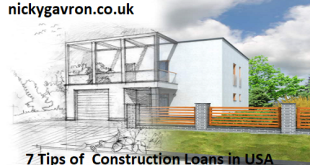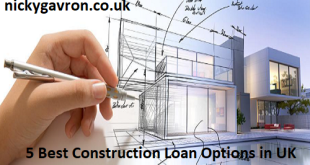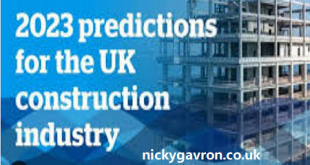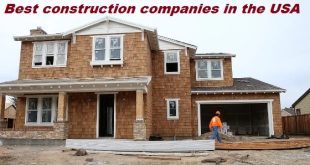Welcome to the dynamic world of commercial construction in the UK. If you have an interest in commercial building trends, the latest innovative ideas, or have plans to embark on a commercial construction project, then you’re in the right place. Strap in as we delve into the current trends shaping Britain’s commercial construction industry.
Understanding current trends is the first step towards making informed decisions in commercial construction. It’s about future-proofing your investment.
Trends Defining Commercial Construction in the UK
Emerging trends in commercial construction are shaped by several factors. These include technological advances, energy efficiency and sustainability concerns, shifts in the market demand, and regulatory developments. All these contribute towards a continuously evolving landscape of commercial construction. In the succeeding sections, we will be exploring each of these aspects in more detail.
- Technological Advances: The transformative impact of technology in various aspects of commercial construction will be one of the topics of focus. From digital blueprints and 3D modeling to smart buildings, tech is revolutionizing the way we build.
- Energy Efficiency and Sustainability: This section will delve into the confluence of construction and sustainability. We’ll take a look into how green building standards and energy-efficient designs are shaping the future of commercial construction.
- Market Shifts: Markets change, and so do the demands for commercial space. We’ll examine the influence of changing market demands on commercial construction.
- Regulatory Developments: Lastly, we’ll discuss how updates in construction regulations and codes impact the commercial construction industry.
Join us, as we take a journey into the heart of commercial construction – its latest trends, innovative ideas, and the forces that continue to shape it. Let’s build a stronger understanding together!
Smart Buildings: Revolutionizing the Commercial Construction Industry
Imagine walking into an office building that adjusts the lighting as you move, manages its own energy usage, and even alerts the custodial staff when a room needs to be cleaned. Welcome to the world of smart buildings, a trend taking over the commercial construction industry in the UK and revolutionizing how we think about and interact with the physical spaces where we work and play.
But what makes a building “smart”? In essence, it’s all about integration. Smart buildings use advanced automation systems to control a variety of operations including heating, ventilation, air conditioning, lighting, security and more. These systems incorporate sensors and microchips to collect data, which is then analyzed to make efficient decisions about resource use and maintenance.
- Energy Efficiency: One of the key advantages of smart buildings is energy efficiency. By monitoring and optimizing energy usage, smart buildings can reduce operating costs and minimize their environmental impact.
- Improved Comfort: Smart buildings can also improve occupants’ comfort by adjusting temperature, lighting, and other variables based on data collected from sensors placed throughout the structure.
- Increased Productivity: Smart buildings can also have a positive impact on productivity. For example, integration with personal calendars can ensure rooms are at the optimal temperature and lighting for scheduled meetings.
Note: These advancements aren’t without their challenges. Like all technology, smart buildings can experience glitches, and their complexity can make maintenance more difficult. Additionally, issues such as cybersecurity and personal privacy can arise when collecting and storing data.
Still, the potential benefits of smart buildings are exciting. As technology continues to progress, the commercial construction industry in the UK is poised to adopt these smart techniques on a grander scale. Current industry trends suggest a continued rise in demand for smart buildings, paving the way for a more efficient, comfortable, and productive commercial future.
Adaptable Designs: Meeting the Changing Needs of Businesses
Imagine a commercial building that alters with the evolving needs of a business or organisation. Yes, you heard it right! Adaptable designs are storming the commercial construction world in the UK. With businesses rapidly changing and growing, the structures that house them must evolve simultaneously or risk becoming obsolete or detrimental to productivity.
What are these Adaptable Designs exactly?
Comparable to the concept of flexibility, ‘adaptable design’ in construction refers to the creation of structures and facilities that can be easily modified or adapted to fit different uses, technologies, and business requirements. Instead of static, rigid blueprints, architects and builders are now conceptualising structures that focus on dynamism and adjustability. Intriguing, isn’t it?
So, how is this achieved? Allow us to break it down for you.
- Modular construction: This allows segments of a building or facility to be created off-site and then transported to the site for assembly. It’s faster, efficient, and can create buildings that are much easier to change or expand.
- Open floor plans: An open floor layout grants businesses the agility to rearrange their environments according to varying needs. Plugs, ports, dividers – with everything on wheels and versatile furnishings, businesses can easily adapt.
- Futureproofed technology infrastructure: Structures are now embedded with advanced technological infrastructure that is easy to update and upgrade over time.
What’s the significance?
Embracing adaptable design is not just a novelty; it comes with tangible benefits that are significant for businesses and investors alike. These include:
- Cost Effectiveness: Adapting an existing structure is often less expensive than demolishing and rebuilding. Thus, clients save money in the long run.
- Sustainability: Updates and modifications can be made with minimal waste, making these designs environmentally friendly. It’s an excellent way to add to your company’s ‘Green Image’.
- Increased Property Value: Adaptable buildings are inherently future-proofed, ensuring they remain relevant, usable, and high in market value for a longer period.
In conclusion, adaptable design is more than just a trend; it’s a transformative approach to commercial construction. Businesses, investors, and builders have begun recognizing the profound impact this trend will have on the future of commercial properties in the UK. You too, should consider it for your next project!
Efficient Project Management: Streamlining Construction Processes
Efficient project management is a vital aspect of the commercial construction sector. It’s about more than coordinating schedules and tracking budgets—it’s a multi-faceted approach that involves planning, executing, and controlling the entire project from inception to completion. In the UK, where the demand for commercial properties is always on an upward trend, streamlined process management has become a game-changer. Let’s explore how this mechanism works:
Planning: The first step in efficient project management is creating a comprehensive plan that encompasses every stage of construction, from site selection to post-construction maintenance. Missteps or vague plans can lead to costly delays. Therefore, project managers in the UK are leveraging advanced planning software and technologies to mitigate risk and improve consistency.
Execution: Once the project is launched, managers need to ensure that every phase is executed as planned. This is often the most intricate part of the process, as it involves coordinating a multitude of tasks while maintaining adherence to the initial plan. In the UK, commercial construction firms are leaning towards using integrated software solutions to improve resource allocation and workflow management.
Control: Monitoring the progress of the project is crucial to ensure that everything stays on track. In the UK, strategic control measures like regular site inspections, automated progress tracking, and data-driven reporting are becoming the new standard in commercial construction management.
One notable trend in UK’s commercial construction project management is the increasing investment in technology. From project management software to AI-powered forecasting tools, the technological transformation is rewriting the rulebook for construction processes, leading to improved efficiency and cost-effectiveness.
Let’s illustrate this with the following case study:
The London-based commercial construction company, ABC Ltd, implemented a cloud-based project management system in early 2020. The system integrated all construction aspects—from planning to execution—into a single platform. By the end of the year, ABC Ltd reported a 15% increase in project efficiency and a 20% reduction in construction costs, proving the significant impact of efficient project management in commercial construction.
As changes and developments continue to redefine the commercial construction landscape in the UK, adopting efficient project management is no longer an option—it’s an absolute necessity. The ability to effectively manage a project from start to finish while adapting to unforeseen circumstances lays the groundwork for successful commercial building construction.
Renewable Energy Integration in Commercial Buildings
When we talk about the future of commercial construction in the UK, renewable energy integration is one hot topic you surely can’t overlook. The way we use energy in commercial buildings is rapidly changing. Can you imagine a building producing more energy than it consumes? This is no more a concept from a distant future. Thanks to recent advancements in renewable technologies, it’s happening now, right here in the UK.
How is this possible? Sit back, let us explain.
Rooftop solar panels, biomass heating systems, and mini wind turbines are some examples of renewable energy sources that are becoming increasingly popular among commercial building developers. Just as important is the idea of energy efficiency. Improved insulation, smart metering systems, and energy-efficient appliances are seen as a basic requirement in modern commercial building designs.
But what are the key trends driving this change? What are the benefits? And what does the future hold? Here’s a closer look:
Key Trends Driving Renewable Energy Integration
- Rising awareness about climate change and environmental sustainability: People are becoming more conscious of their responsibility towards the environment, resulting in increasing demand for green buildings.
- Government incentives: In the UK, there are numerous financial incentives for businesses to increase their use of renewable energy and improve energy efficiency.
- Technological advancements: New technologies, like smart grids and energy storage systems, are paving the way for better incorporation of renewable energy.
Benefits of Renewable Energy Integration
- Reduced operating costs: Using renewable energy and improving energy efficiency can result in significant cost savings in the long term.
- Improved corporate image: Embracing renewable energy helps businesses show their commitment towards environmental sustainability and can enhance their public image.
- Increased property value: Commercial buildings with energy-efficient designs and renewable energy systems can command higher rent and sales prices.
In short, the trend towards renewable energy in commercial construction isn’t just about doing the right thing for the planet – it also makes great business sense.
Looking Ahead: The Future of Renewable Energy Integration
But what about the future? The good news is that many experts believe that we are just in the early stages of this revolution. As renewable energy technology continues to develop and become cheaper, it’s likely that we’ll see even more innovative applications for renewable energy in commercial buildings.
To sum it up, the integration of renewable energy in commercial construction is a trend that’s here to stay, and it’s definitely shaping the future of the construction industry in the UK. So, if you’re involved in commercial construction, don’t get left behind. Start exploring how you can make the most of these exciting developments today.
Strategies for Cost-Effective Commercial Construction
When it comes to commercial construction, cost-effectiveness is a crucial aspect that can’t be overlooked. Achieving a balance between cost and quality is a delicate art, but with the right strategies, it is possible to maintain high standards without breaking the bank. Here are a few strategies worth considering:
- Error Minimisation: Mistakes can be costly. Invest in meticulous planning and employ technology to detect errors before they happen. Regular inspections, either in-person or through digital platforms, will ensure your new commercial building remains on-budget and up to standard.
- Efficient Resource Management: Good management of resources, whether they be material, manpower, or money, can significantly decrease overall project costs. Efficiency is key: minimise waste, maximise productivity, and every pound will go a whole lot further.
- Lean Construction Practices: Lean construction is all about eliminating waste in the commercial construction process, whether that be waste of materials, time or effort. These techniques streamline your operations, making everything run more smoothly and cost-effectively.
- Invest in Technology: The latest technology can often improve efficiency, reduce errors, and lead to cost savings. Consider investing in advanced software for project management, the latest construction technologies, and innovative machinery for the job site. The initial cost may be high, but the long-term benefits more than justify the investment.
Remember, every construction project is different, and therefore requires a tailored approach. However, the outlined strategies provide a good starting point for any commercial construction project aiming to be cost-effective.
The Role of Value Engineering
In the context of achieving cost-effectiveness, value engineering plays a pivotal role. Value engineering is a methodical approach to improve the function of a product or service while reducing its overall costs. This process involves analysing all components of a commercial construction project, from materials to methods, to identify areas for potential cost savings without compromising on quality or functionality.
“Value engineering doesn’t mean cutting corners – it’s about fine-tuning the project to ensure maximum value.”
Applying value engineering principles can offer significant benefits such as reducing cost, improving the quality, enhancing performance, and maximising the overall value of a commercial construction project.
Transforming Commercial Landscapes: Outdoor Design Trends
Commercial landscapes aren’t just about sleek skyscrapers and modern office buildings anymore. A significant shift in outdoor design is underway, with a focus on incorporating natural elements and prioritizing aesthetics, functionality and sustainability. Let’s delve into some of the transformative outdoor design trends emerging in the UK’s commercial construction industry.
Greenery and Biophilic Design
Gone are the days of sterile and stark corporate landscapes. Today, greenery has made its way into commercial design through lawns, rooftop gardens, and shrub-lined walkways. This trend isn’t solely aesthetic. It stems from the concept of biophilic design, which seeks to incorporate natural elements into commercial constructs to boost occupants’ well-being. This not only creates a more visually pleasing environment, but studies suggest it can also increase productivity and overall employee satisfaction.
Landscaping as a Functional Space
Commercial landscapes are becoming more than just decorative perimeters for buildings. Architects and construction companies are recognizing the value of functional outdoor spaces for businesses. These spaces come in many forms – relaxation zones, outdoor meeting rooms, sporting areas, all designed to provide a multifunctional area that serves the diverse needs of businesses and their employees.
Sustainability and Environmentally-Friendly Design
In line with global efforts to mitigate climate change, the trend towards sustainable design in commercial landscapes is obvious. This includes rain gardens to manage stormwater runoff, solar panels to harness renewable energy, and the use of native plants to improve biodiversity. These features not only lessen a commercial building’s environmental impact but can also lead to significant cost savings in the long run.
Use of Technology in Landscape Design
Via software platforms and 3D modeling, technology is transforming how commercial landscapes are designed and executed. These tools allow for visualizing and altering designs before their implementation, ensuring optimal use of space and resources. Advanced technology also enhances collaborations between teams, making the entire construction process more streamlined and efficient.
In conclusion, outdoor design trends in commercial construction are undergoing a transformation. The focus is now on creating functional, aesthetically pleasing, and sustainable landscapes that cater to the evolving needs of businesses and their employees, and which positively contribute to the overall urban landscape. This paradigm shift is yet another example of how the UK’s commercial construction industry is leading the way with innovative and forward-thinking ideas.
The Future of Commercial Construction: Insights and Predictions
The pace of technological innovation and changing societal attitudes towards sustainability are set to significantly alter the landscape of commercial construction in the UK. As you navigate these trends, let’s take a peek into what experts are predicting for the future of this industry.
Automation and Robotics: In the face of labour shortages and the relentless demand for cost efficiency, automation and robotics are poised to become much more commonplace. This evolution isn’t just about machine-operated cranes and trucks either. Think about 3D printing, drones for aerial surveys, and AI-powered tools that enable contractors to forecast project costs with unprecedented accuracy.
Adoption of Building Information Modelling (BIM): Already taking root in many parts of the world, BIM is an intelligent 3D model-based process that gives architecture, engineering, and construction professionals the tools to plan, design, construct, and manage buildings more efficiently. More than just a trend, BIM represents a paradigm shift, that is set to become the new standard in commercial construction.
“The combined impacts of digital technologies and new construction methods will not only make the commercial construction industry more efficient and innovative, but importantly, make our built environment more sustainable.” – Matt Gough, Director, Mace Group
Moving Towards Net-Zero Buildings: As the UK government commits to reaching net zero carbon emissions by 2050, new and existing commercial structures are expected to follow suit. Expect a surge in the demand for passive designs, materials with low embodied carbon, and renewable energy solutions like solar panels and geothermal systems.
Increased Use of Modular Construction: Fast, efficient, and minimally disruptive, modular construction where buildings are prefabricated offsite, is gaining traction. Moving much of the build process into the controlled environment of a factory not only speeds up construction times by as much as 50%, but can also significantly reduce waste, thus supporting sustainability goals.
Mental Health Considerations: With the increasing emphasis on employee well-being, the design and construction of workplaces that promote mental health are expected to become more prominent. Elements such as natural lighting, green spaces, and noise-reducing materials are slated to become integral to commercial construction.
In concluding, it’s clear that the commercial construction industry is at the cusp of some exciting transformations. As we move forward, the challenge will be to embrace these trends while continuing to deliver cost-effective solutions that meet the evolving needs of businesses.
FAQs :
- What is a smart building and how is it revolutionizing commercial construction?A smart building, at its most basic, utilizes the latest automation and Internet of Things (IoT) technologies to ensure the utmost efficiency in energy and operational management. By automatically adjusting heating, cooling, and lighting based on occupancy, not only is energy waste minimized, but so is the cost of operation. In the UK, the rise of smart building technology is ushering in a new era of commercial construction, prioritizing sustainability, energy-efficiency, and enhanced living conditions.
- How do adaptable designs cater to the changing needs of a business?Adaptable designs, often referred to as ‘flexible’ designs, are innovative construction solutions that allow for easy modifications to the space according to real-time needs. These designs can accommodate fluctuations in business scales, staffing needs, or even the emergence of new technology. Their growing popularity in commercial construction springs from their ability to extend a building’s life, promote efficient use of space, and eventually save money.
- In what ways does integrating renewable energy benefit commercial constructions?Renewable energy integration in commercial buildings is a trend set to change the face of the industry. This integration reduces reliance on traditional power sources, consequently lowering energy costs and carbon footprints. Moreover, it aligns businesses with their environment-conscious customer base, thereby enhancing their corporate image. In addition, with incentives offered by the UK government, the financial benefits of such integration are increasingly appealing.
- What strategies can aid in cost-effective commercial construction?Effective project management, value engineering, and smart choice of materials and technology are key strategies for cost-effective construction. Project management streamlines the construction process, helps prevent cost overruns, and ensures timely completion. Value engineering focuses on retaining crucial features and functions while removing elements that add unnecessary costs. Employing energy-efficient technologies also result in substantial savings in the long term.
- What does the future look like for commercial construction in the UK?The future of commercial construction in the UK appears to be heading towards more sustainable, smart, and adaptable designs. As businesses become more environmentally aware, the demand for green buildings is expected to rise. Smart buildings offering extensive automation will continue to evolve, becoming the norm rather than the exception. Taking into consideration the ever-changing dynamics of businesses, flexible designs offering easy scalability will also gain popularity. All in all, it’s an exciting time for commercial construction in the UK!








